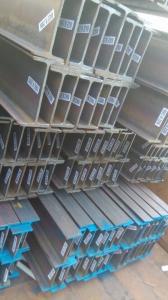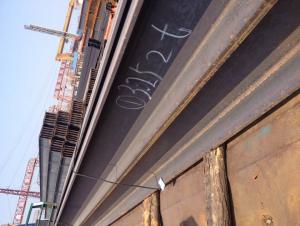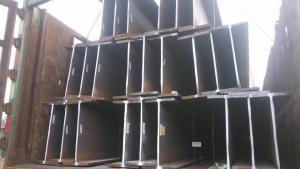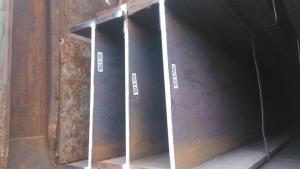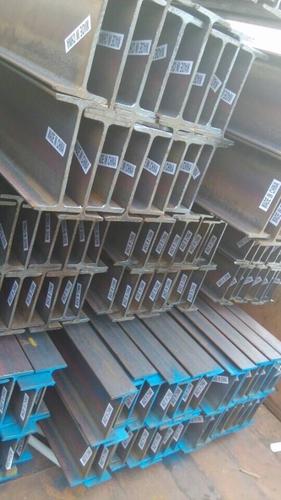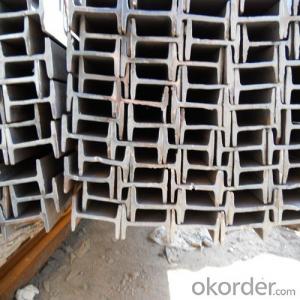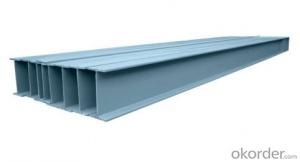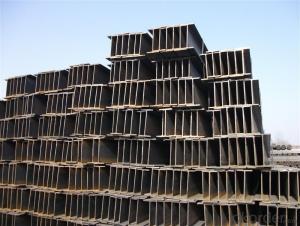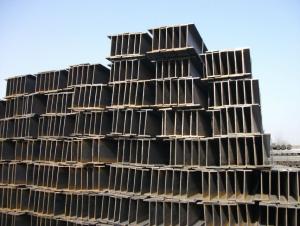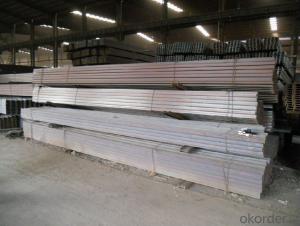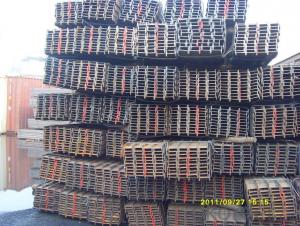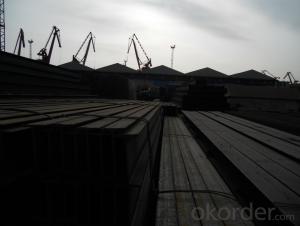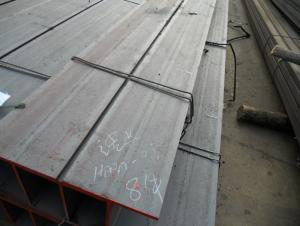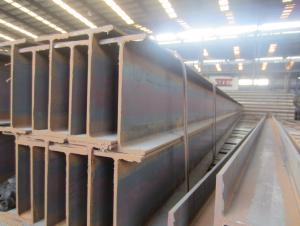Steel H Beam for Steel Structure
- Loading Port:
- China Main Port
- Payment Terms:
- TT or LC
- Min Order Qty:
- 100 m.t.
- Supply Capability:
- 5000MT m.t./month
OKorder Service Pledge
OKorder Financial Service
You Might Also Like
Product Description:
OKorder is offering Steel H Beam for Steel Structure at great prices with worldwide shipping. Our supplier is a world-class manufacturer of steel, with our products utilized the world over. OKorder annually supplies products to African, South American and Asian markets. We provide quotations within 24 hours of receiving an inquiry and guarantee competitive prices.
Product Applications:
Steel H Beam for Steel Structure are ideal for structural applications and are used in commercial building structure; pre-engineered buildings; machinery support structure; prefabricated structure; medium scale bridges; ship-building structure etc.
Product Advantages:
OKorder's Steel H Beam for Steel Structure are durable, strong, and wide variety of sizes.
Main Product Features:
· Premium quality
· Prompt delivery & seaworthy packing (30 days after receiving deposit)
· Can be recycled and reused
· Mill test certification
· Professional Service
· Competitive pricing
Product Specifications:
Manufacture: Hot rolled
Grade: Q195 – 235
Certificates: ISO, SGS, BV, CIQ
Length:12m, as per customer request
Packaging: Export packing, nude packing, bundled
size | Kg/m |
100*100 | 16.9 |
125*125 | 23.6 |
150*75 | 14 |
150*150 | 31.1 |
148*100 | 20.7 |
198*99 | 17.8 |
200*100 | 20.9 |
248*124 | 25.1 |
250*125 | 29 |
FAQ:
Q1: what is the difference between actual weight and theoretical weight?
A1: All the section steel has two weights: actual weight and theoretical weight. Actual weight is the weighing out when the product delivered from the mill. Theoretical weight is calculated by pieces. The invoice can be based on each of them as your request.
Q2: How do we guarantee the quality of our products?
A2: We have established an advanced quality management system which conducts strict quality tests at every step, from raw materials to the final product. At the same time, we provide extensive follow-up service assurances as required.
Q3: How soon can we receive the product after purchase?
A3: Within three days of placing an order, we will arrange production. The normal sizes with the normal grade can be produced within one month. The specific shipping date is dependent upon international and government factors, the delivery to international main port about 45-60days.
Images:

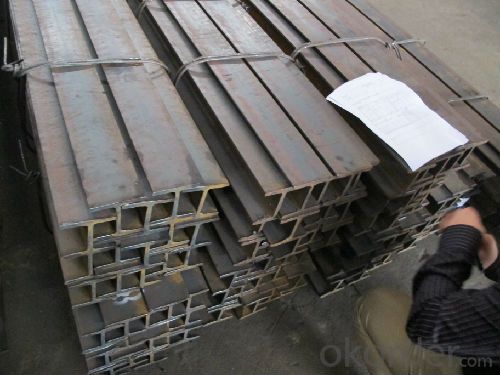
- Q: What are the common fabrication techniques used for steel H-beams?
- Steel H-beams are fabricated using several common techniques, including hot rolling, welding, and cutting. The primary fabrication technique for producing steel H-beams is hot rolling. This involves heating a large steel billet and passing it through a series of rollers to shape it into the desired H-beam profile. Through this process, H-beams with consistent dimensions and excellent structural integrity are created. Welding is another crucial technique used in fabricating steel H-beams. It entails joining multiple steel plates or sections together to form the H-beam shape. Welding can be performed using various techniques, such as arc welding, MIG welding, or TIG welding, depending on the project's specific requirements. By creating a continuous and seamless connection between the different components, welding enhances the strength and rigidity of the H-beam. Cutting is also a widely employed technique in the fabrication of steel H-beams. It involves removing excess material to achieve the desired dimensions and shape. Various cutting methods, such as sawing, shearing, or plasma cutting, can be utilized. This process ensures precise and accurate shaping of the H-beam, meeting the required specifications. In summary, these fabrication techniques are vital for the production of steel H-beams as they guarantee their structural integrity, dimensional accuracy, and overall quality.
- Q: Can Steel H-Beams be used in laboratory or research facility construction?
- Yes, Steel H-Beams can be used in laboratory or research facility construction. They are commonly used for their structural strength, durability, and ability to support heavy loads. Steel H-Beams provide stability and are often preferred for their resistance to fire, earthquakes, and other potential hazards. Furthermore, their versatility allows for easy integration into various architectural designs and flexible space arrangements.
- Q: Can steel H-beams be used in the construction of theme resorts or hotels?
- Yes, steel H-beams can be used in the construction of theme resorts or hotels. Steel H-beams are commonly used in construction due to their strength, durability, and load-bearing capabilities. They provide structural support and stability, making them suitable for large-scale projects like theme resorts or hotels. Additionally, steel H-beams can be customized and easily assembled, allowing for flexibility in design and construction.
- Q: How do steel H-beams compare to I-beams in terms of strength?
- Steel H-beams and I-beams are both common structural elements used in construction, but they differ in their shape and design. In terms of strength, H-beams and I-beams have different load-bearing capacities due to their structural characteristics. H-beams, also known as wide flange beams, have a wider flange and a narrower web compared to I-beams. This design allows H-beams to support heavy loads over a wider span, making them suitable for applications that require greater strength and stability. The wider flange of H-beams provides increased resistance to bending, torsional forces, and shear stress, making them well-suited for structures such as bridges, buildings, and heavy machinery. On the other hand, I-beams, also known as universal beams or rolled steel joists, have a narrow flange and a thicker web. This particular shape allows I-beams to resist bending and deflection, making them ideal for applications that require long spans and minimal sagging. I-beams are commonly used in residential and commercial construction, as well as in the manufacturing of beams and columns. In terms of comparing the strength of H-beams and I-beams, it is important to consider the specific dimensions, material properties, and loading conditions. Generally, H-beams have a higher load-bearing capacity compared to I-beams due to their wider flange and greater resistance to various types of forces. However, it is crucial to consult structural engineers or reference load tables to determine the appropriate beam type and size for a specific construction project. In conclusion, while both steel H-beams and I-beams are strong structural elements, H-beams generally have a higher load-bearing capacity due to their wider flange design. However, the choice between H-beams and I-beams depends on the specific requirements and loading conditions of the construction project.
- Q: Can steel H-beams be used in wastewater treatment plant construction?
- Indeed, steel H-beams are applicable for construction in wastewater treatment plants. Their strength and durability render them a popular choice in the construction field. In the realm of wastewater treatment plants, these beams serve a multitude of structural purposes, including the support of heavy equipment, the formation of building frameworks, and the provision of load-bearing reinforcement for pipelines and ductwork. The corrosion-resistant properties of steel make it an ideal material for deployment in wastewater treatment plants, where exposure to water, chemicals, and other adverse environmental conditions is commonplace. Moreover, steel H-beams can be customized to meet specific design specifications, thereby establishing their versatility as a construction option within the wastewater treatment industry.
- Q: How do you calculate the section modulus of steel H-beams?
- In order to calculate the section modulus of steel H-beams, one must have knowledge of the moment of inertia of the beam's cross-sectional shape. The section modulus serves as a geometric attribute that gauges the beam's ability to resist bending. It is determined by dividing the moment of inertia by the distance between the neutral axis and the furthest point on the cross-section of the beam. To calculate the section modulus of steel H-beams, follow these steps: 1. Establish the moment of inertia (I): The moment of inertia indicates how the area of the cross-section is distributed around the neutral axis. It can be computed using standard formulas or obtained from engineering tables specific to H-beams. The moment of inertia will differ depending on the size and shape of the H-beam. 2. Determine the distance to the furthest point (c): Measure the distance from the neutral axis to the furthest point on the cross-section. Typically, this distance is equal to half the height of the H-beam. 3. Compute the section modulus (Z): Divide the moment of inertia (I) by the distance to the furthest point (c). The resulting value represents the section modulus. Section Modulus (Z) = Moment of Inertia (I) / Distance to furthest point (c) The section modulus is normally expressed in cubic inches or cubic millimeters, depending on the unit system in use. It signifies the beam's resistance to bending and can be utilized to determine the beam's strength and deflection under different loading conditions. It's crucial to note that the section modulus is a characteristic specific to the cross-sectional shape of the beam. It is employed in structural engineering calculations for the design and analysis of steel H-beams in various applications.
- Q: What is the lifespan of steel H-beams?
- The lifespan of steel H-beams can vary depending on several factors such as the quality of the steel used, the conditions in which the beams are used, and the level of maintenance they receive. Generally, steel H-beams are designed to be durable and long-lasting, making them suitable for various structural applications. If properly manufactured and maintained, steel H-beams can have a lifespan of several decades or even longer. The high strength and structural integrity of steel allow it to withstand heavy loads, extreme weather conditions, and other external factors that can potentially degrade the material over time. However, it is important to note that various factors can contribute to the deterioration of steel H-beams. These factors include exposure to corrosive elements such as moisture, chemicals, and saltwater, as well as structural overload, excessive vibrations, and improper installation or handling. Regular inspections and maintenance are crucial to identify any signs of corrosion, fatigue, or structural damage that may affect the lifespan of the beams. In summary, the lifespan of steel H-beams can be extensive if they are well-manufactured, properly maintained, and used within their design limitations. By implementing appropriate maintenance practices and protecting the beams from adverse conditions, it is possible to extend their lifespan significantly.
- Q: Can steel H-beams be used in seismic zones?
- Yes, steel H-beams can be used in seismic zones. Steel is a popular material choice for seismic construction due to its strength, flexibility, and ductility. H-beams, also known as I-beams, provide excellent structural support and can withstand the forces generated during seismic events. To ensure the safe use of steel H-beams in seismic zones, it is important to follow specific design and construction guidelines. These guidelines include factors such as selecting the appropriate material grade, size, and shape of the beams, as well as proper connection and reinforcement detailing. Design considerations such as the beam's moment of inertia, section modulus, and rigidity play a crucial role in determining the beam's ability to resist seismic forces. Additionally, the connections between the beams and other structural elements should be designed to accommodate the potential lateral and vertical movements that can occur during an earthquake. It is also important to comply with local building codes and regulations specific to seismic zones. These codes typically outline specific design parameters, construction techniques, and materials requirements to ensure structures can withstand seismic activity. By following these guidelines and adhering to local building codes, steel H-beams can be effectively used in seismic zones, providing a safe and reliable structural solution.
- Q: How do steel H-beams perform in terms of energy efficiency?
- Steel H-beams are generally not considered to be energy efficient in and of themselves. This is because steel production, including the manufacturing of H-beams, requires a significant amount of energy. The process involves extracting iron ore, refining it into steel, and shaping it into the desired H-beam form. These steps consume a significant amount of energy, primarily in the form of fossil fuels. However, when evaluating the energy efficiency of a structure that incorporates steel H-beams, it is important to consider the overall lifecycle of the building. Steel H-beams have several advantages that can contribute to the energy efficiency of a building. Firstly, steel is a durable and long-lasting material, which means that structures built with steel H-beams tend to have a longer lifespan compared to other building materials. This longevity can result in energy savings over time, as the building requires less frequent maintenance and replacement. Additionally, steel H-beams offer excellent structural strength and load-bearing capabilities. This allows for the construction of larger open spaces with fewer supporting columns, which can maximize natural lighting and ventilation. By reducing the need for artificial lighting and mechanical ventilation, steel H-beams can contribute to energy efficiency by reducing electricity consumption. Furthermore, steel is a highly recyclable material, and the majority of steel used in construction today is made from recycled steel. This recycling process significantly reduces the energy consumption and greenhouse gas emissions associated with steel production. Additionally, at the end of a building's life, steel materials can be easily and efficiently recycled, further minimizing environmental impacts. In summary, while the production of steel H-beams is energy-intensive, their use in construction can offer energy efficiency benefits. Their durability, load-bearing capacity, and recyclability contribute to the overall energy efficiency of buildings. However, it is essential to consider the entire lifecycle of the structure and incorporate sustainable design principles to maximize energy efficiency.
- Q: Are steel H-beams resistant to saltwater exposure?
- Yes, steel H-beams are generally resistant to saltwater exposure. Steel is known for its durability and strength, making it a popular choice in construction materials, including H-beams. However, it is important to note that prolonged exposure to saltwater can still cause corrosion over time. To mitigate this risk, extra precautions such as proper coating and maintenance should be taken to ensure the longevity of the steel H-beams in saltwater environments.
Send your message to us
Steel H Beam for Steel Structure
- Loading Port:
- China Main Port
- Payment Terms:
- TT or LC
- Min Order Qty:
- 100 m.t.
- Supply Capability:
- 5000MT m.t./month
OKorder Service Pledge
OKorder Financial Service
Similar products
Hot products
Hot Searches
Related keywords
